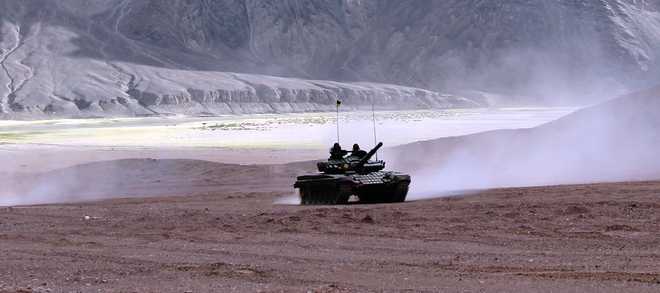
Past three years have seen additions to mechanised forces and artillery guns, backed by tanks.
Ajay Banerjee
Eastern Ladakh, if left unattended, could prove to be Indias jugular vein in a future war. The Line of Actual Control with China is not marked, its perceptions are contested by both sides. In 1962, the area saw pitched battles, those at Rezang La, Srijap were well-contested. While India is ramping up, Beijing already has its infrastructure with roads and upcoming rly link. War may be a far cry, but both the armies are on their toes. The Tribune presents a five-part ground report series
It was in 2012 that India quietly changed its tactics and started accumulating a large number of forces in eastern Ladakh facing China. Four years later, the accretions and infrastructure-push is literally in full swing in the area with a 826-km frontier with China.
The Tribune visited key locations across the length and breadth of this strategic frontier, geographically defined by the military as the area from the Karakoram Pass in the north to Demchok in the south-east. Its here that a possibility exists for China and Pakistan to launch a collusive two-front war against India.
The Karakoram ranges in India, if occupied by China, can threaten New Delhis hold over Siachen as well as cut off the Depsang plains and Daulat Baig Oldie (DBO).
In the past four-five years, ground troops have been added to pre-positioned locations along the Line of Actual Control (LAC), or the de facto border, that is not marked on the ground. In the past 36 months, additions to mechanised forces and artillery guns have been made, backed by the T-72 Russian- origin tanks.
Another tank unit is slated to move to eastern Ladakh. This adds a new dimension to any future war in the area that is marked by an average height of 14,000 feet, where oxygen is scarce.
The force accretion is seven to eight times more than it was in 1962. History of the Conflict with China, 1962 produced 30 years after the war by the Historical Division of the Ministry of Defence, says eastern Ladakh had just four battalions, including the JK militia (later renamed as Ladakh Scouts).
(Follow The Tribune on Facebook; and Twitter @thetribunechd)
Lt Gen SK Patyal, Commander of the Leh-based 14 Corps, says: “We have to defend our international borders, whatever it takes in terms of infrastructure and accretion, we are doing in the best possible manner.”
Sources point out that more than 50 per cent of the troop strength in Eastern Ladakh came in the past four-five years. Battalions are tasked to be on the Line of Actual Control (LAC) for a two year tenure. The area of responsibility is documented for the next to take over. For example, an advance party of a battalion which is to take over in August-end arrived at a post near the LAC in May.
A back-up reserve has been created called the ‘loop battalions’. These are kept acclimatised for any need for induction at these rarefied-oxygen heights of 14,000 feet.
However, the biggest move is the tanks. The plateaus interspersed in the folds of the major mountain ranges — the Greater Himalayas, Karokaram, Ladakh and Zanskar — are ideal tank country, flat with ample places to hide in the folds of the valleys.
Colonel Vijay Dalal, who is commanding an armoured unit, says: “We have to use additives and use winter grade diesel. In the winter, every night the tanks parked in garages are revved up a couple of times to prevent the parts from freezing.”
During the 1962 India-China war, five of the US-built AMX-13 tanks were airlifted. In his book ‘My Years with the IAF’, former IAF chief PC Lal explains the great difficulty faced in modifying the AN-12 transport planes to airlift the tanks.
Not just the accretions, the fortified defences, new bunker-style positions, dot the mountain spurs along the LAC. New fortified roads that allow 50-tonne tanks to drive are showing up, maybe India is ‘designing a battlefield’ to suit its strengths. At least numerically, the Indian move promises to hold back any aggression by China.
(To be concluded)



























